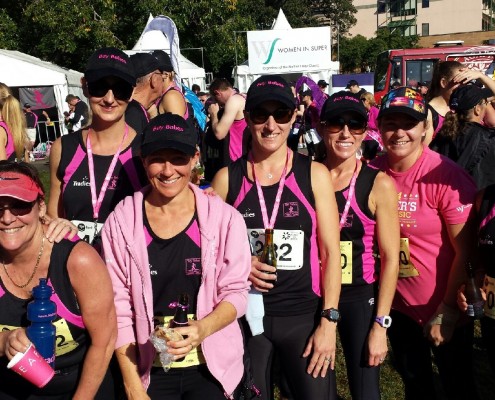The Importance of Electrolytes When Exercising
Sweating Much This Week???
With the current heat wave upon us and the fact that we are all continuing to exercise or train for upcoming events (which is great), we need to take a closer look at Electrolyte replacement to ensure that we can get the most out of our training and recovery.
What are electrolytes?
Electrolytes are important nutrients for our bodies as they play key roles in sending electrical impulses that influence our heart, muscles and nerves. They also play an important role in fluid balance and hydration in our cells, tissues, and our muscles. Lack of sufficient electrolytes can contribute to muscle cramps, delayed muscle soreness (DOMS) and spasms following exercise, and can contribute to headaches.
Symptoms of Electrolyte Imbalance
• dark urine (a sign of dehydration)
• irregular heartbeat
• fatigue
• lethargy
• convulsions or seizures
• nausea and/or vomiting
• bowel irregularities (including diarrhea and constipation)
• abdominal cramping
Where are Electrolytes Found?
Electrolytes include sodium, potassium, calcium, chloride and magnesium. Most often electrolytes can be found in foods but they can also be found in beverages such as coconut water and juices made from electrolyte-rich fruits and vegetables. Electrolytes cannot be consumed by drinking water as water lacks these important electrolytes.
Which Foods Contain Electrolytes?
Foods that are naturally higher in electrolytes include all plant-based foods, but particularly fruits and vegetables, and primarily those that are red, orange, and/or yellow. These fruits and vegetables not only contain a rich-source of potassium but are also good source of magnesium. Nuts, seeds, and beans are also a good source of magnesium and calcium, but are not rich sources of potassium and sodium. Green leafy vegetables can also be a good source of calcium and potassium.
Good sources of Potassium:
– Beans (white beans)
– Green leafy vegetables: spinach, chard, kale, beet leaves
– Potatoes
– Bananas
– Dried apricots
– Yellow Squash, butternut pumpkin and zucchini
– Avocados
– Red, yellow and orange fruits and vegetables: bananas, beetroots, oranges, capsicums.
– Coconut water
Good sources of natural Sodium:
– Celery
– Beetroot
– Bok choy/Pak Choy, Asian Greens
– Capsicums (red, yellow, orange)
I also don’t mind a bit of good old Aussie Vegemite which is high in sodium, as is table salt, however salt is added to many packaged foods so minimise the amount you use.
Magnesium
Magnesium supports bone and teeth development, nerve and muscle function and enzyme activation. Getting enough magnesium in your diet also protects you from high blood pressure, a factor that increases your risk of heart disease, and helps to combat osteoporosis. It is found in leafy green vegetables, nuts, cereals, beans and tomato paste. Magnesium cannot be stored in the body so if you are not getting enough in your diet consider a supplement. You need a small amount of magnesium daily, about 400 milligrams for men and 300 milligrams for women.
Calcium
The body uses calcium for bone and teeth formation, blood clotting, muscle and enzyme function and normal heart rhythms. Calcium is most commonly found in milk and milk products. It is also in meat, fish with bones such as salmon, sardines, eggs, fortified breakfast cereals, beans and certain fruits such as dried apricots and figs, and vegetables such as asparagus and leafy greens. Aim for at least 1,000 milligrams of calcium each day.
Good sources of Magnesium and Calcium
- Beans
- Nuts & seeds such as pumpkin and sunflower seeds, wholegrains and yoghurt (magnesium mainly)
- Almonds, cashews, sunflower & sesame seeds, brazil nuts and pine nuts (highest content)
- Green leafy vegetables (calcium) and wheat-based grains (magnesium)
Electrolytes Post-Exercise
When you sweat, you primarily lose potassium and sodium, therefore to replenish the electrolytes lost, you can make a juice made from red, yellow, and orange produce (for natural sodium) with some green leafy vegetables (for potassium) to help replenish. Coconut water is also a great source of both potassium and sodium and is lower in calories and sugars. Try mixing the fruit and veg in coconut water or just have on its own. For the most part, coconut water is also higher than most juices in electrolytes, and therefore can make for a great way to replenish electrolytes lost through sweat.
Pre or Post-Exercise?
If you are participating in a high intensity exercise or training when it is very hot and humid, it’s important to prepare your body with electrolytes prior to exercising. For most, it may be more beneficial to drink 500-600mls of an electrolyte-rich beverage such as coconut water or electrolyte-rich juice, prior to exercising instead of waiting until after the exercise session.
Pre-exercise, your body is more likely to benefit from a higher electrolyte beverage as you provide your body with sufficient electrolytes before losing them through sweat.
Post-exercise, the focus should be more on a protein-rich beverage to repair muscle damage due to the exercise session. Dairy products contain key electrolytes and are also a source of protein and carbohydrate.
You can also use Staminade, Gatorade or similar to increase your electrolyte intake before, during or after exercise, but these are higher in sugars unless you are using a sugar free product (not a bad thing if you also need more carbohydrate intake for energy). Other electrolyte sources that are great are Hammer Endurolytes (a capsule) that can be taken with water, or various effervescent tablets that can be added to a drink bottle from brands like GU, Hammer, High 5, Endura.
What About Water?
Though water does not contain a good source of electrolytes, it still plays an important role in hydration and should not be forgotten.



